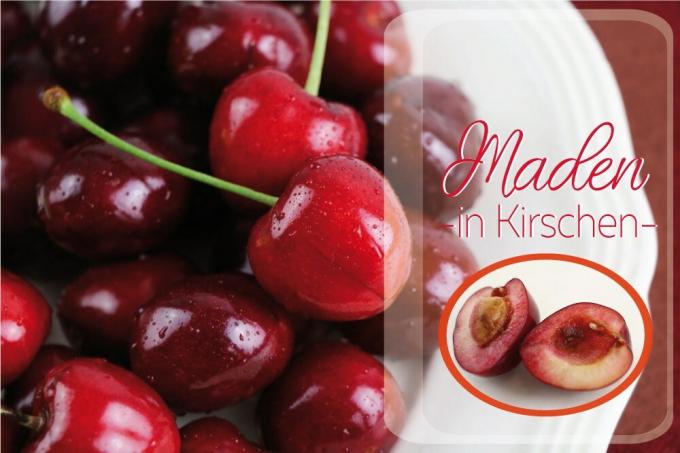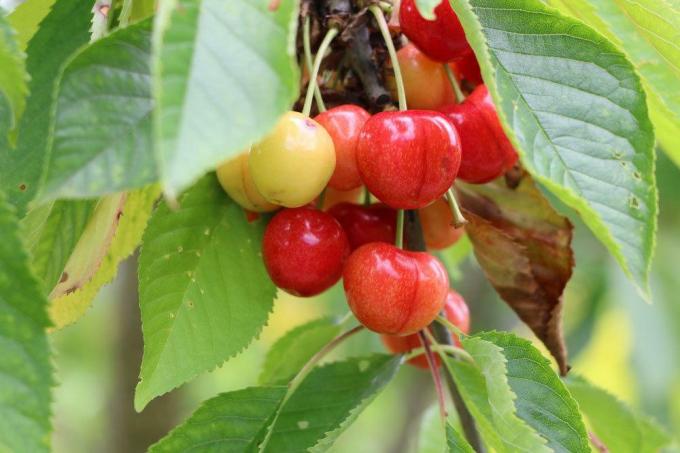
table of contents
- Larvae
- Remove maggots
- water bath
- Combat
- Yellow panels
- Chicken
- Fleece or foil
Eating bright red sweet cherries fresh from the tree can be a real pleasure. However, it is not uncommon for sweet cherries to contain an undesirable “meat insert”. In other words: many cherries are infested with cherry fruit flies or their maggots. You will hardly suffer any harm if you eat a few of these larvae, but very few people find it very appetizing.
Larvae
Under what circumstances are there particularly many larvae?
For the number of larvae present, this is on the one hand weather responsible, but also the chosen one Cherry variety. In warm, dry summers there are a lot of fly maggots, but the small animals are less fond of damp and cool weather. So rain and cold during the egg-laying time are useful to keep the population low.

They hatch around the end of May Cherry fruit flies. They begin to lay eggs about 14 days later. To do this, they choose unripe, yellow to light red fruits. Early cherry varieties that are in a different stage of ripeness at this time are therefore spared from the maggot. In the other fruits the eggs ripen from which the larvae hatch a little later.
Remove maggots
How do I get the maggots out of the fruits?
The only way to find out whether your cherries are actually infested with larvae is to look. You can cut open the cherry and then remove the maggot immediately. However, this takes a lot of work and significantly reduces the enjoyment of the sweet fruits. But at least you don't have to eat the maggot that way.

water bath
Instead, place your freshly picked cherries in a cool water bath. After about ten minutes, the fruits begin to soak up water. Since this is uncomfortable for the maggots, the animals leave the affected fruit and swim on the water. It's not a pretty sight, but you can now simply skim the larvae from the surface of the water and dispose of them in the organic waste bin. Unfortunately, this method is not 100 percent successful. Some particularly stubborn larvae will likely remain in the cherries.
Combat
Can I keep the cherry fruit fly maggots away from my cherry trees?
Chemical agents used to control cherry fruit flies are not permitted in private gardens. You must therefore resort to other means. For a successful fight against the cherry fruit fly, you need to know what its life and development cycle is like. The larvae hatch about five to twelve days after they have laid their eggs and eat the pulp. After about 30 days, the larvae leave the mostly rotten fruits and bury themselves in the earth to overwinter. It is important to interrupt this cycle.

Effective means of controlling the cherry fruit fly:
- plant early cherry varieties
- Keeping chickens under the trees
- Pull safety nets over the trees
- Prevent pupation in the ground
Yellow panels
Yellow panels attract the cherry fruit fly, which then sticks to the panels. However, these panels are only really effective with a very small population of cherry trees. In the case of large trees and stands, they only serve as indicators of an infestation.
Chicken
Chickens are used several times to combat the cherry fruit fly. On the one hand, they are already scratching and pecking the larvae and pupae out of the ground so that no more flies can hatch from them. Later in the year they eat the falling cherries with the maggots they contain.

Fleece or foil
You can also use a fleece or foil under the cherry tree to prevent the larvae from crawling into the ground and pupating there. To do this, however, you have to collect or sweep and destroy falling fruits and larvae on a daily basis. However, the ground around the corresponding cherry tree must be covered as early as May. You may only remove the fleece or film again after the very last fruits have been harvested.
